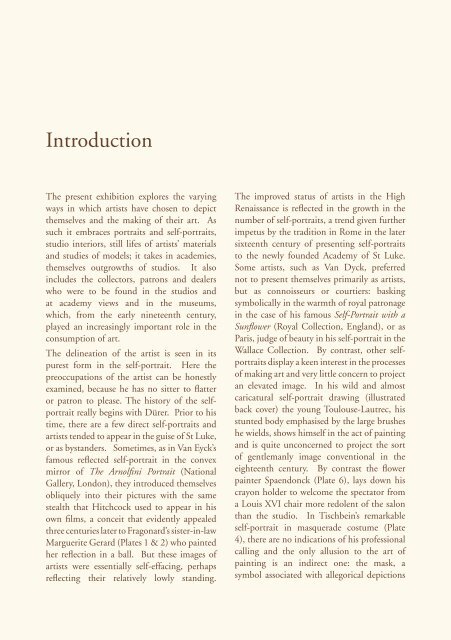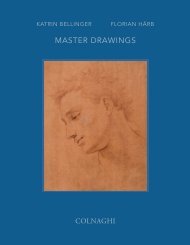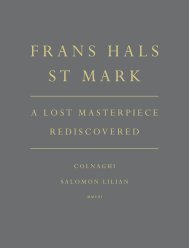AA 2.indd - Colnaghi
AA 2.indd - Colnaghi
AA 2.indd - Colnaghi
Create successful ePaper yourself
Turn your PDF publications into a flip-book with our unique Google optimized e-Paper software.
Introduction<br />
The present exhibition explores the varying<br />
ways in which artists have chosen to depict<br />
themselves and the making of their art. As<br />
such it embraces portraits and self-portraits,<br />
studio interiors, still lifes of artists’ materials<br />
and studies of models; it takes in academies,<br />
themselves outgrowths of studios. It also<br />
includes the collectors, patrons and dealers<br />
who were to be found in the studios and<br />
at academy views and in the museums,<br />
which, from the early nineteenth century,<br />
played an increasingly important role in the<br />
consumption of art.<br />
The delineation of the artist is seen in its<br />
purest form in the self-portrait. Here the<br />
preoccupations of the artist can be honestly<br />
examined, because he has no sitter to flatter<br />
or patron to please. The history of the selfportrait<br />
really begins with Dürer. Prior to his<br />
time, there are a few direct self-portraits and<br />
artists tended to appear in the guise of St Luke,<br />
or as bystanders. Sometimes, as in Van Eyck’s<br />
famous reflected self-portrait in the convex<br />
mirror of The Arnolfini Portrait (National<br />
Gallery, London), they introduced themselves<br />
obliquely into their pictures with the same<br />
stealth that Hitchcock used to appear in his<br />
own films, a conceit that evidently appealed<br />
three centuries later to Fragonard’s sister-in-law<br />
Marguerite Gerard (Plates 1 & 2) who painted<br />
her reflection in a ball. But these images of<br />
artists were essentially self-effacing, perhaps<br />
reflecting their relatively lowly standing.<br />
The improved status of artists in the High<br />
Renaissance is reflected in the growth in the<br />
number of self-portraits, a trend given further<br />
impetus by the tradition in Rome in the later<br />
sixteenth century of presenting self-portraits<br />
to the newly founded Academy of St Luke.<br />
Some artists, such as Van Dyck, preferred<br />
not to present themselves primarily as artists,<br />
but as connoisseurs or courtiers: basking<br />
symbolically in the warmth of royal patronage<br />
in the case of his famous Self-Portrait with a<br />
Sunfl ower (Royal Collection, England), or as<br />
Paris, judge of beauty in his self-portrait in the<br />
Wallace Collection. By contrast, other selfportraits<br />
display a keen interest in the processes<br />
of making art and very little concern to project<br />
an elevated image. In his wild and almost<br />
caricatural self-portrait drawing (illustrated<br />
back cover) the young Toulouse-Lautrec, his<br />
stunted body emphasised by the large brushes<br />
he wields, shows himself in the act of painting<br />
and is quite unconcerned to project the sort<br />
of gentlemanly image conventional in the<br />
eighteenth century. By contrast the flower<br />
painter Spaendonck (Plate 6), lays down his<br />
crayon holder to welcome the spectator from<br />
a Louis XVI chair more redolent of the salon<br />
than the studio. In Tischbein’s remarkable<br />
self-portrait in masquerade costume (Plate<br />
4), there are no indications of his professional<br />
calling and the only allusion to the art of<br />
painting is an indirect one: the mask, a<br />
symbol associated with allegorical depictions








